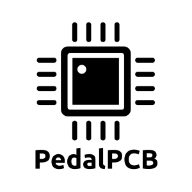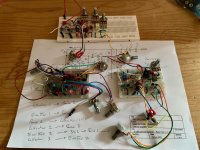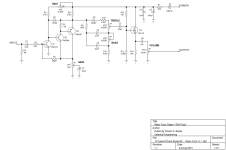You are using an out of date browser. It may not display this or other websites correctly.
You should upgrade or use an alternative browser.
You should upgrade or use an alternative browser.
How did you learn to read schematics?
- Thread starter Ericmc
- Start date
That's a good question. I think I started reading schematics and relating them to Vero layouts and amp layouts. I started with tube amps, and there are lots of old Fender diagrams available online, although I started with those in books. There aren't so many different types of parts so you get to recognise the symbols fairly quickly.
Old Fender amp diagrams are of two kinds. First there are the schematics and secondly there are layout diagrams, designed to show a tech where everything was supposed to be in the actual amp chassis. Schematics allow you to see the signal flow more easily than most layout diagrams, so it's useful to have both and not just rely on the layouts. If you're not sure what a symbol means it's super easy to google them.
I don't think I ever sat down to learn how to read schematics - I probably should have. It just came about from trying to build amplifiers and pedals and having to work out what they meant. I guess starting out with a simple fuzz or boost circuit and identifying what each bit does is a start. I also think that building Vero boards is an easier way of seeing the difference between a layout and a schematic than using PCBs. PCBs are fantastic for building but can be difficult for a newbie to work out how everything is connected.
Old Fender amp diagrams are of two kinds. First there are the schematics and secondly there are layout diagrams, designed to show a tech where everything was supposed to be in the actual amp chassis. Schematics allow you to see the signal flow more easily than most layout diagrams, so it's useful to have both and not just rely on the layouts. If you're not sure what a symbol means it's super easy to google them.
I don't think I ever sat down to learn how to read schematics - I probably should have. It just came about from trying to build amplifiers and pedals and having to work out what they meant. I guess starting out with a simple fuzz or boost circuit and identifying what each bit does is a start. I also think that building Vero boards is an easier way of seeing the difference between a layout and a schematic than using PCBs. PCBs are fantastic for building but can be difficult for a newbie to work out how everything is connected.
damianvila
Well-known member
BuddytheReow
Breadboard Baker
Walk before you can run. Then learn about the various circuit blocks out there.
 forum.pedalpcb.com
forum.pedalpcb.com
TUTORIAL - What Are All Those Symbols? - Intro to Schematic Reading
You've got your breadboard, jumper wires, offboard components, and breadboard components in hand and are ready to go. You download a build doc from PedalPCB website, skip the pretty picture of the PCB, skip the components listing since your order came in the mail 3 and a half minutes ago, get to...
damianvila
Well-known member
RetiredUnit1
Well-known member
I learned on Rob Robinette's site. It has a SQUAT load of tube amp stuff as well, how they work, how to build them, how to modify, etc...
mybud
Well-known member
Try breadboarding some simple circuits. Here's the 1304 with variants that I've been working on for awhile.


@BuddytheReow and @Chuck D. Bones provide some excellent guides to breadboarding and modding. I have found breadboarding especially useful when dealing with components that need biasing (JFETs, and so on). It takes a bit of patience and the right gear (see post #5 above) but very rewarding when the circuit works.
And it's worth labelling them from the start, so you know what it is six months down the road. Ask me how I know.
Good luck. NGBS, as in 'Now go breadboard something.'


@BuddytheReow and @Chuck D. Bones provide some excellent guides to breadboarding and modding. I have found breadboarding especially useful when dealing with components that need biasing (JFETs, and so on). It takes a bit of patience and the right gear (see post #5 above) but very rewarding when the circuit works.
And it's worth labelling them from the start, so you know what it is six months down the road. Ask me how I know.
Good luck. NGBS, as in 'Now go breadboard something.'
Feral Feline
Well-known member
Osmosis
A bit at a time, each new circuit, something new would come up — for example stuff that at first glance looked the same, but were somehow slightly different.
Various Triangles



When you have a complex schematic littered with triangles, some of the details may be lost upon someone new to reading these circuit road-maps.
I searched for "schematic symbols" online and found some good charts and diagrams that I kept handy while trying to fathom whatever schematic and circuit I was working on. A bit at a time, constant reinforcement, repetition & relearning ie constant practice... kind of like learning an instrument.

And I'm still learning new things...
A bit at a time, each new circuit, something new would come up — for example stuff that at first glance looked the same, but were somehow slightly different.
Various Triangles



When you have a complex schematic littered with triangles, some of the details may be lost upon someone new to reading these circuit road-maps.
I searched for "schematic symbols" online and found some good charts and diagrams that I kept handy while trying to fathom whatever schematic and circuit I was working on. A bit at a time, constant reinforcement, repetition & relearning ie constant practice... kind of like learning an instrument.

And I'm still learning new things...
neiltheseal
Active member
I learned how to read schematics because I am so sloppy when putting pedals together. My first 2 pedals I made worked, but from then on i had constant issues. To fix these issues i built an audio probe and bought a multimeter and just methodically went through the schematic trying to find the problem.
After doing this a few times I found that I could read schematics and started to recognise basic patterns like 2 transistor fuzz, big muff, clipping diodes, power sections.
Turns out being sloppy was good after all. I managed to acquire a skill that I probably never would have other wise. I recently ordered some PCBs that I laid out myself. Fingers crossed they work.
After doing this a few times I found that I could read schematics and started to recognise basic patterns like 2 transistor fuzz, big muff, clipping diodes, power sections.
Turns out being sloppy was good after all. I managed to acquire a skill that I probably never would have other wise. I recently ordered some PCBs that I laid out myself. Fingers crossed they work.
Barry
Well-known member
I was educated on reading schematics drawn in AC voltage, so the transition to the DC voltage was a bit of a challenge after so many years of looking at the previous. Then throw an audio path in the mix as well. I still have to make myself stop and think about the different logic.
BuddytheReow
Breadboard Baker
How did I learn how to read schematics? Honestly, a lot of reading with the motivation of "how does all this crap work?" I have no EE training other than a high school physics class. You can look for the 'Resources' thread in the Test Kitchen for lots of places to catch up on. IMO, if you really know nothing I would suggest truly going back to basics to learn about electricity. This link was very useful, although it is a textbook of sorts and great for beginners. https://www.allaboutcircuits.com/textbook/
spi
Well-known member
I learned it in high school electronics class. Nobody else has? Our education system has failed us.
I guess they don't teach it because most people never need it (I took it as an elective), but I think it has value as you learn some science and engineering (not to mention systems thinking) in the process.
As for advice how to learn it--find a good textbook or these days you can probably find youtube videos that explain stuff.
I guess they don't teach it because most people never need it (I took it as an elective), but I think it has value as you learn some science and engineering (not to mention systems thinking) in the process.
As for advice how to learn it--find a good textbook or these days you can probably find youtube videos that explain stuff.
KR Sound
Well-known member
I had a semester of electronics when I was in high school, but that was 30 years ago!I learned it in high school electronics class. Nobody else has? Our education system has failed us.
I guess they don't teach it because most people never need it (I took it as an elective), but I think it has value as you learn some science and engineering (not to mention systems thinking) in the process.
As for advice how to learn it--find a good textbook or these days you can probably find youtube videos that explain stuff.
Cybercow
Well-known member
Personally, I learned how to read schematics in the 70's when I took a 2-yr correspondence "Color TV Electronics" course that I finished in 9 months. (I was hungry to learn electronics.) It's all about connecting the dots between symbols and real-life parts identification. The symbols on the schematic are ½ of the overview. The other half is being able to match the symbols to actual real-life components. Then there are the polarity identifiers where applicable. Also, there are distinctions between analog, digital and hybrid circuits.
Today, Google is the best friend of those want to learn new things. After entering "how to read schematics" into Google, a crap load of links will point the way. Here are just a couple:
https://learn.sparkfun.com/tutorials/how-to-read-a-schematic/all
https://www.circuitbasics.com/how-to-read-schematics/
More than anything, time & patience will be good friends on the journey to understanding electronics.
Today, Google is the best friend of those want to learn new things. After entering "how to read schematics" into Google, a crap load of links will point the way. Here are just a couple:
https://learn.sparkfun.com/tutorials/how-to-read-a-schematic/all
https://www.circuitbasics.com/how-to-read-schematics/
More than anything, time & patience will be good friends on the journey to understanding electronics.
spi
Well-known member
over 30 for me too! Although I don't remember the details and have to look up stuff, I still have the (now fuzzy) foundations ingrained in me.I had a semester of electronics when I was in high school, but that was 30 years ago!
Last edited:
Similar threads
- Replies
- 27
- Views
- 1K

